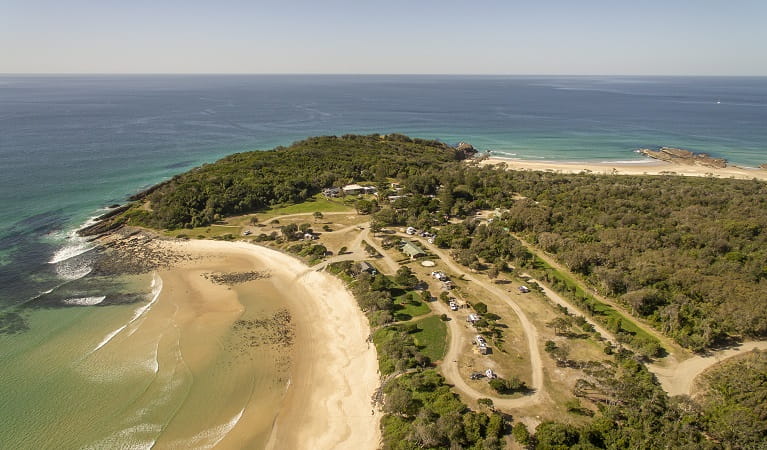Limeburners Creek National Park
Overview
Hidden between Crescent Head and Port Macquarie, you’ll find this idyllic coastal retreat. Escape to the beachside and enjoy walks, scenic views, and world-class surfing.
Read more about Limeburners Creek National Park
Hidden away between Crescent Head and Port Macquarie on the mid north coast, you’ll find this idyllic stretch of pristine coast. Get off the beaten track and enjoy this remote piece of beachside paradise.
Discover golden sandy beaches, amazing surf breaks, remote camping spots and fascinating Aboriginal cultural heritage. With options for swimming, fishing, walking or just lazing on the beach, it makes for a fantastic family holiday or a relaxing beachside retreat.
The sparkling coastline of heathlands, banksia and blackbutt forest and the rare rainforests of Big Hill provide habitat to an abundance of wildlife. You’ll see ospreys, pied oystercatchers, dingoes, koalas, quolls, and if you’re lucky, the rare ground parrot. You may even spot majestic black swans gliding over the waters of Saltwater Lake.
Local alerts
For the latest updates on fires, closures and other alerts in this area, see https://www.nationalparks.nsw.gov.au/visit-a-park/parks/limeburners-creek-national-park/local-alerts
Contact
- in the North Coast region
Limeburners Creek National Park is always open but may have to close at times due to poor weather or fire danger
-
$8 per vehicle per day.
Buy annual pass. -
-
Kempsey office
02 6561 6700
Contact hours: Monday to Friday, 9am to 4.30pm. - 247 Old Station Rd, Verges Creek NSW 2440
-
Email: npws.hastingsmacleay@environment.nsw.gov.au
-
Kempsey office
Visitor info
All the practical information you need to know about Limeburners Creek National Park.
Map
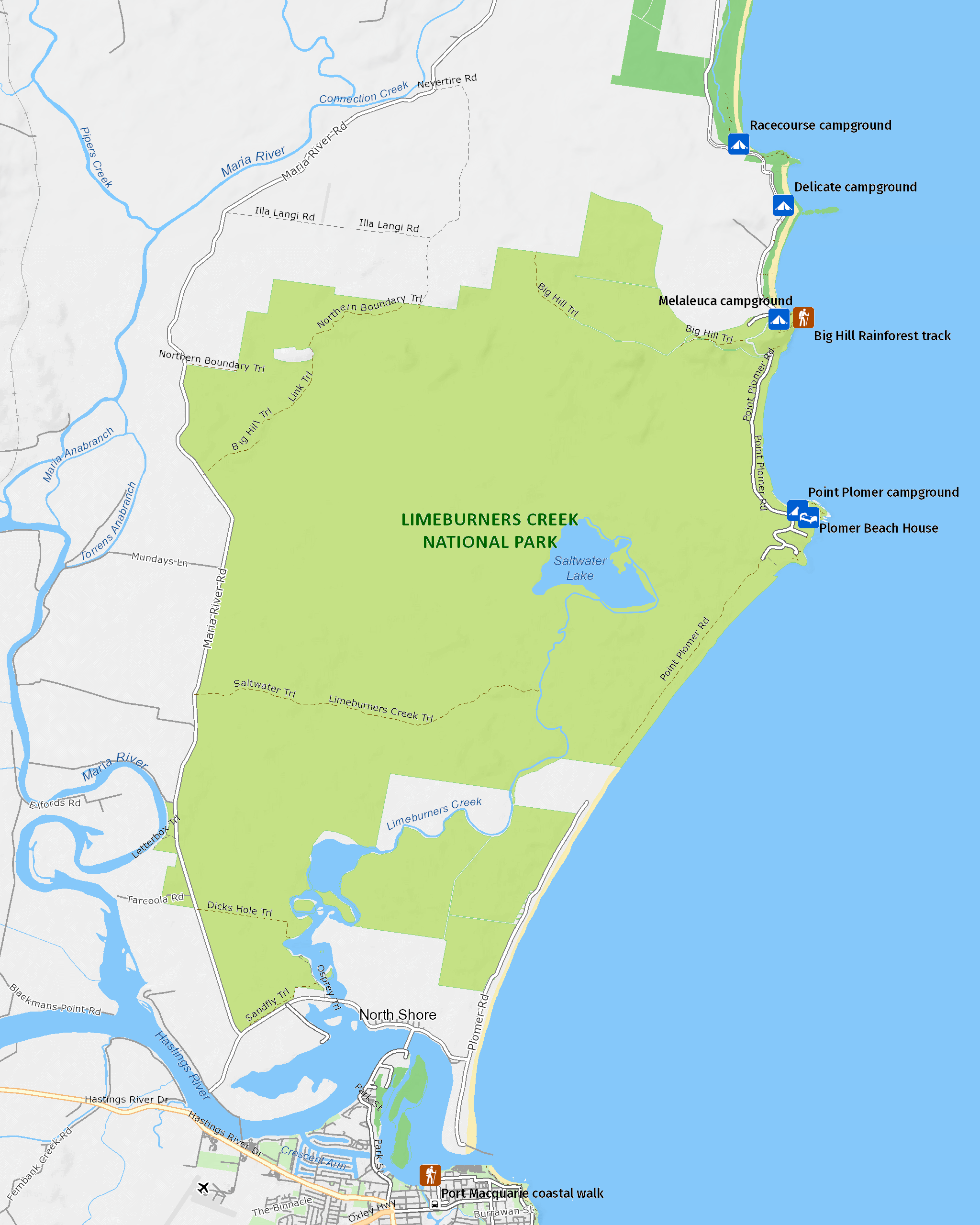
Map legend

Getting there and parking
Get driving directions
From Kempsey or Crescent Head:
- Drive towards Crescent Head from Kempsey
- As you enter Crescent Head village, turn right into Point Plomer Road, also known as Bakers Road.
- Continue 14km on sometimes rough gravel road to the park
- Point Plomer is a further 3km
From Port Macquarie:
- Suitable for 4WD only
- Take the Settlement Point Ferry to North Shore
- From Riverside Drive, turn right onto Shoreline Drive.
- Continue onto North Shore Drive
- Turn left onto Plomer Road and follow to the park
Parking
- Melaleuca campground See on map
- Point Plomer campground See on map
By bike
Check out the Bicycle information for NSW website for more information.
By public transport
Limeburners Creek National Park is not accessible by public transport. The nearest transport hubs are Kempsey or Port Macquarie. For information about public transport options, visit the NSW country transport info website.
Best times to visit
There are lots of great things waiting for you in Limeburners Creek National Park. Here are some of the highlights.
Spring
Watch the heathland wildflowers burst with colour and enjoy long walks on the beach as you look out for whales in the distance.
Summer
Take the kids to Point Plomer for a family holiday by the beach, swimming by day and discovering the star-filled skies by night.
Winter
Take advantage of the better surf conditions in winter and a chance to spot whales on their migration north.
Weather, temperature and rainfall
Summer temperature
Average
17°C and 26°C
Highest recorded
42.3°C
Winter temperature
Average
7°C and 19°C
Lowest recorded
0°C
Rainfall
Wettest month
February
Driest month
August
The area’s highest recorded rainfall in one day
1387.6mm
Facilities
Toilets
Picnic tables
Barbecue facilities
Boat ramp
Showers
Electric power
Maps and downloads
Fees and passes
$8 per vehicle per day.
- All Parks Pass - For all parks in NSW (including Kosciuszko NP) $190 (1 year) / $335 (2 years)
- Multi Parks Pass - For all parks in NSW (except Kosciuszko) $65 (1 year) / $115 (2 years)
- Country Parks Pass - For all parks in Country NSW (except Kosciuszko) $45 (1 year) / $75 (2 years)
- Single Country Park Pass - For entry to a single park in country NSW (except Kosciuszko). $22 (1 year) / $40 (2 years)
Annual passes and entry fees (https://www.nationalparks.nsw.gov.au/passes-and-fees)
Prohibited
Pets
Pets and domestic animals (other than certified assistance animals) are not permitted. Find out which regional parks allow dog walking and see the pets in parks policy for more information.
Smoking
NSW national parks are no smoking areas.
Nearby towns
Crescent Head (12 km)
Crescent Head on the NSW North Coast is surrounded by some of the stunning natural environments in the State. As well as long stretches of coastline with fabulous beaches, there is a string on coastal national parks to explore. Go surfing, fishing, boating and bushwalking, enjoy bird watching or whale watching, spot dolphins, turtles and even koalas in the wild.
Port Macquarie (12 km)
Vibrant Port Macquarie is surrounded by beautiful waterways - the Hastings River, canals, creeks, bays and the Pacific Ocean. The city also has a five-star collection of golden-sand beaches stretching from Port Macquarie Beach to Town Beach and north along the 16-km swathe of North Beach.
Kempsey (32 km)
Kempsey is a historic river town close to national parks and majestic beaches. Kempsey is a convenient place for an overnight stop for anyone driving between Sydney and the North Coast.
Learn more
Limeburners Creek National Park is a special place. Here are just some of the reasons why:
Wildlife and bird watching haven
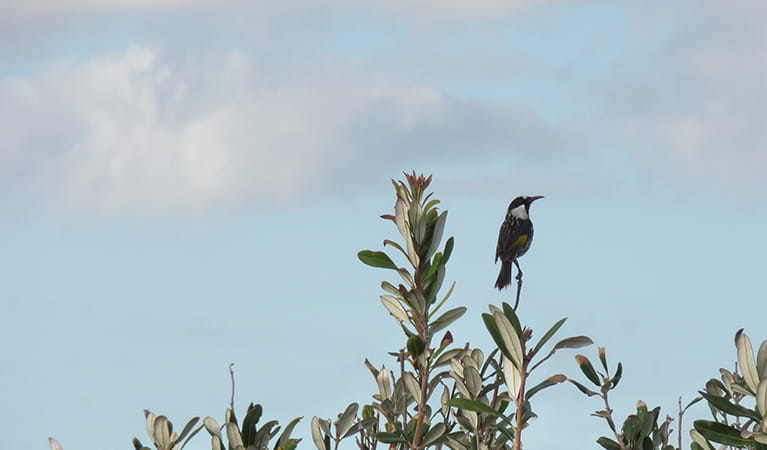
Limeburners Creek National Park is a hot spot for animals. Spotted tail quoll, dingos, butterflies, micro bats, giant pythons and even brolgas make their home here. Birdwatchers will also be in heaven. You'll see rare pied oystercatchers and little terns along beaches, osprey and other large birds of prey circling above and migratory seabirds on their journey north. You might also see the rare ground parrot out in the grass and heathlands.
- Big Hill Rainforest walking track Discover lush rainforest, rocky headlands, spectacular views and abundant wildlife along Big Hill Rainforest walking track.
- Multi-day pack free hike on NSW Mid-North Coast Journey through untouched, coastal landscapes on this 3-day, pack-free walk with Positive Energy Adventures and Retreats. You’ll walk 34km across the beautiful Limeburner’s National Park and Goolawah National Park.
Strong Aboriginal cultural connections
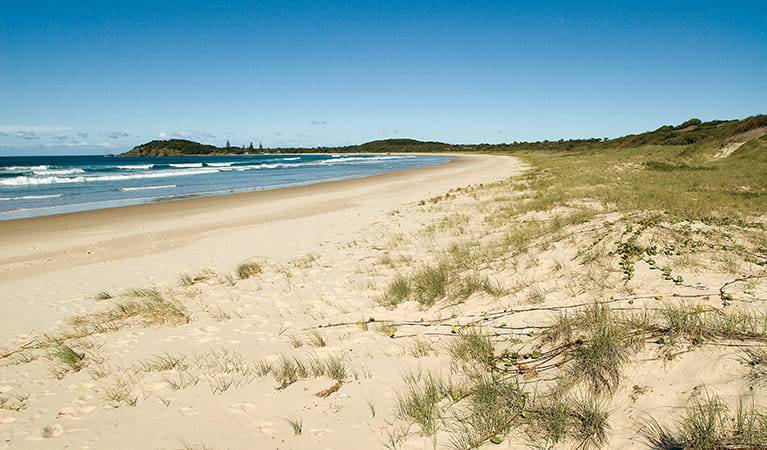
The Dunghutti People from Kempsey and the Biripai people from Port Macquarie continue to have a strong connection with the area surrounding Limeburners Creek. Point Plomer and Big Hill in particular are Aboriginal sites of outstanding significance. Several sites and artefacts tracing Aboriginal settlement in this region back to at least 6,000 years have been found, including burial sites, shell middens, a quarry for stone tool production and axe grinding grooves in rock outcrops around Point Plomer.
A place of historic heritage
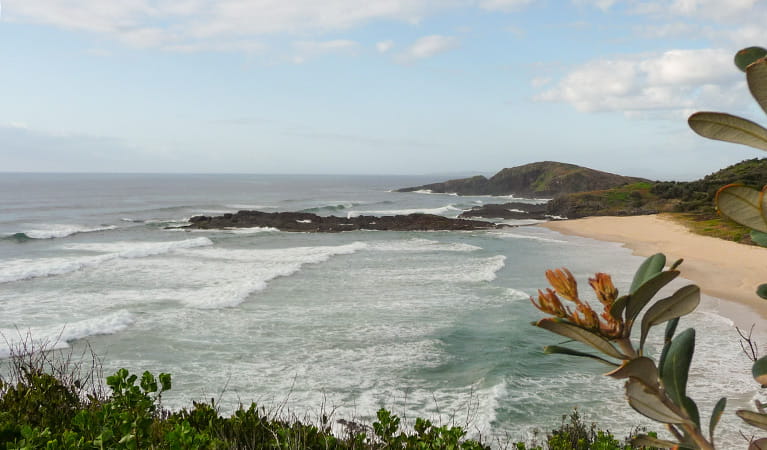
Back in the early days of the Port Macquarie penal settlement, lime for building mortar was in great demand. They used to collect and burn enormous quantities of oyster shells from this area, giving the park its unusual name. Many of the landmarks in the park were named after some of the more colourful pioneers of the past. Barries Bay was originally a whaling station, named after the Barrie family who lived there for many years. Big Hill was named after Kevin Hill, reputedly a hermit who lived on the northwest side of the hill during the Great Depression of the 1930s.
Plants and animals protected in this park
Animals
-
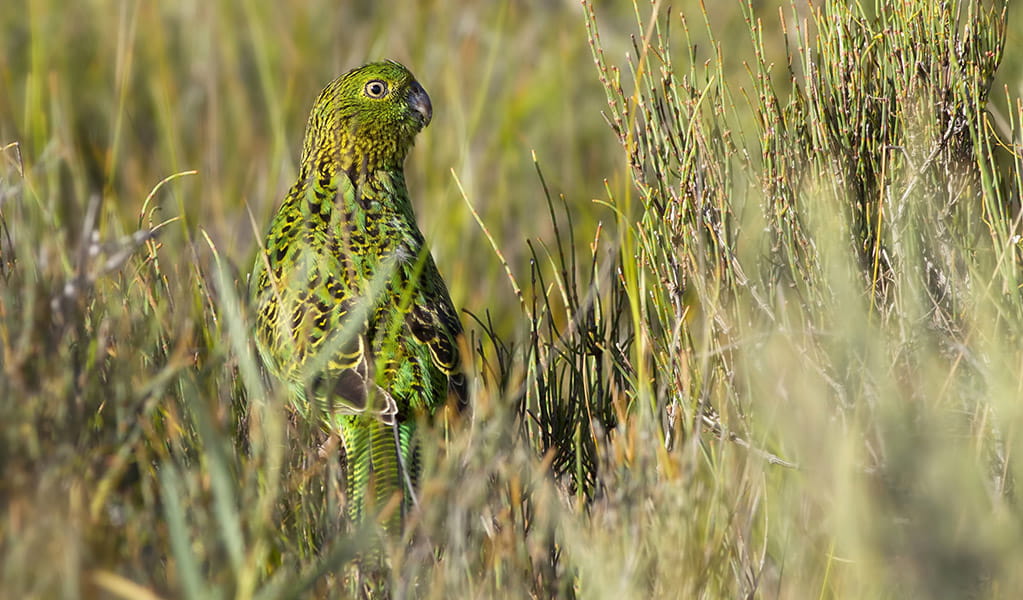
Eastern ground parrot (Pezoporus wallicus wallicus)
The eastern ground parrot is a beautiful, ground-dwelling native bird that lives in low heathland habitat along the NSW North and South coasts and escarpments. It’s listed as a vulnerable species in NSW.
Education resources (1)
What we're doing
Limeburners Creek National Park has management strategies in place to protect and conserve the values of this park. Visit the OEH website for detailed park and fire management documents.

